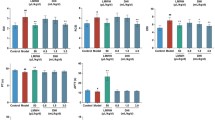Abstract
Tong-Mai oral liquid, containing three herbs (Pueraria radix, radix Salviae miltiorrhizae and rhizoma Chuanxiong), is a formula created under the theory of traditional Chinese medicine (TCM) to invigorate the ‘blood’ and dispel ‘blood stasis’, which arises from poor blood circulation. In Tong-Mai formula, Pueraria radix is used for improved blood circulation and to treat cardiovascular diseases and arrhythmia. Radix Salviae miltiorrhizae was widely used in TCMs for treatment of coronary heart disease, blood circulation diseases, and other cardiovascular diseases; rhizoma Chuanxiong is used to treat thrombosis and platelet aggregation. Clinically, combining the use of these herbs was therapeutically valuable, which suggests that they might synergistically prevent thrombosis. In this study, the pharmacokinetic behaviors of puerarin and daidzein in rat plasma were studied after orally administrated to four kinds of extracts. Puerarin and daidzein were set as index components. In the Tong-Mai oral liquid group, puerarin and daidzein showed the maximum plasma concentration and the lowest clearance rate of plasma. The results indicated that the herbal constituents in Tong-Mai formula showed synergism, and it may be helpful to certificate the rationality of the matching in Tong-Mai formula.





Similar content being viewed by others
References
Li CH, Chen AJ, Chen XF, Chen XG, Hu ZD (2005) J Pharm Biomed Anal 39:125–131. doi:10.1016/j.jpba.2005.03.018
Li HL, Zhang WD, Liu RH, Zhang C, Han T, Wang XW, Wang XL, Zhu JB, Chen CL (2006) J Chromatogr B Analyt Technol Biomed Life Sci 831:140–146. doi:10.1016/j.jchromb.2005.11.049
Makino T, Wakushima H, Okamoto T, Okukubo Y, Deguchi Y, Kano Y (2003) Phytother Res 17:1021–1024. doi:10.1002/ptr.1286
Wang Y, Niu F, Zhao M, Zhong B, Hao J, Yan W, Lu X, Wang W, Li Q, Lin Q, Dai Y, Zhao Y, Xiao M, Tang L, He L, Jiang X, Guo W, Wang S, Lu W (2002) J Tradit Chin Med 22:87–92
Meezan E, Meezan EM, Jones K, Moore R, Barnes S, Prasain JK (2005) J Agric Food Chem 53:8760–8767. doi:10.1021/jf058105e
Zhang S, Chen S, Shen Y, Yang D, Liu X, Sun-Chi AC, Xu H (2006) Biol Pharm Bull 29:945–950. doi:10.1248/bpb.29.945
Gao Q, Pan HY, Qiu S, Lu Y, Bruce IC, Luo JH, Xia Q (2006) Life Sci 73:3183–3196
Zhang GQ, Hao XM, Dai DZ, Fu Y, Zhou PA, Wu CH (2003) Acta Pharmacol Sin 24:1212–1216
Keung WM, Vallee BL (1998) Phytochemistry 47:499–509. doi:10.1016/S0031-9422(97)00723-1
Sun WJ, Sheng JF (1998) Handb Nat Active Const 1:165–472
Chen G, Zhang JX, Ye JN (2001) J Chromatogr A 923:255–262. doi:10.1016/S0021-9673(01)00996-7
Xiong FL, Sun XH, Gan L, Yang XL, Xu HB (2006) Eur J Pharmacol 529:1–7. doi:10.1016/j.ejphar.2005.10.024
Bo J, Ming BY, Gang LZ, Lei C, Jia AL (2005) Neurosci Res 53:183–188. doi:10.1016/j.neures.2005.06.014
Choo MK, Park EK, Yoon HK, Kim DH (2002) Biol Pharm Bull 25:1328–1332. doi:10.1248/bpb.25.1328
Arora A, Nair MG, Strasburg GM (1998) Arch Biochem Biophys 356:133–141. doi:10.1006/abbi.1998.0783
Vedavanam K, Srijayanta S, O’Reilly J, Raman A, Wiseman H (1999) Phytother Res 13:601–608. doi:10.1002/(SICI)1099-1573(199911)13:7<601::AID-PTR550>3.0.CO;2-O
Zou JM, Meng J, Yan ZH (2002) Zhong Cao Yao 33:55–58
Pang ZG, Wang BQ, Li HF (2001) J Xian Med Univ 22:319–321
Zhai XJ, Qu HB, Shao Q, Cheng YY (2007) Chromatographia 66:43–47. doi:10.1365/s10337-007-0253-3
Acknowledgments
This study was financially supported by the National Basic Research Program of China (No. 2005CB523402) and Chinese Key Technologies R&D Program (2004BA721A44).
Author information
Authors and Affiliations
Corresponding author
Rights and permissions
About this article
Cite this article
Zhai, XJ., Qu, HB. & Shao, Q. Studies of the Synergistic Actions of Three Herbs in Tong-Mai Formula. Chroma 69, 1267–1273 (2009). https://doi.org/10.1365/s10337-009-1064-5
Received:
Revised:
Accepted:
Published:
Issue Date:
DOI: https://doi.org/10.1365/s10337-009-1064-5




